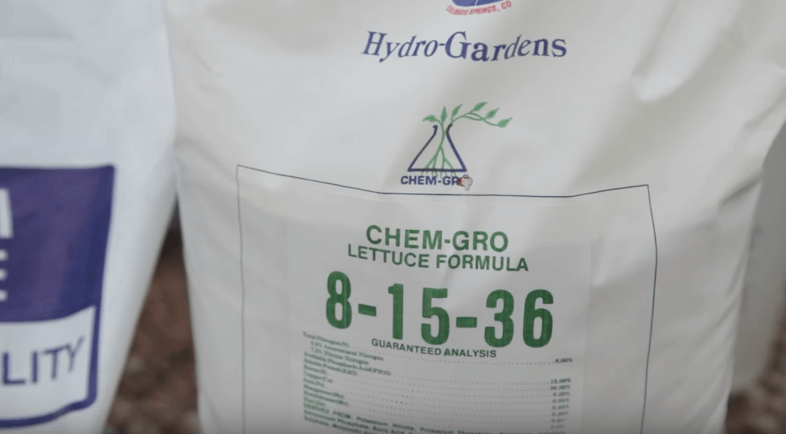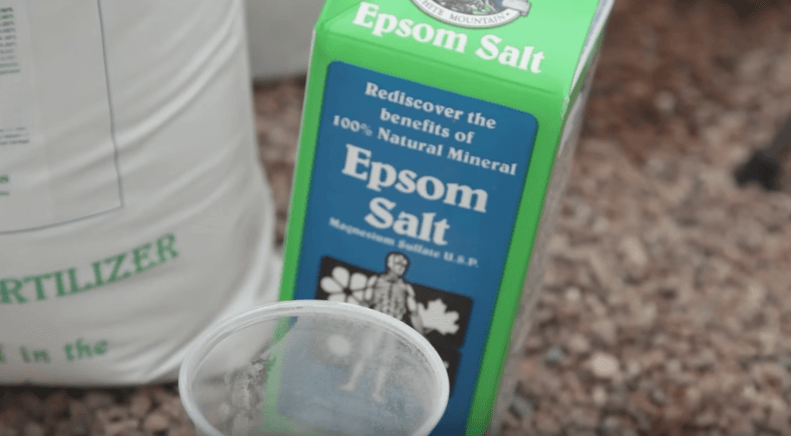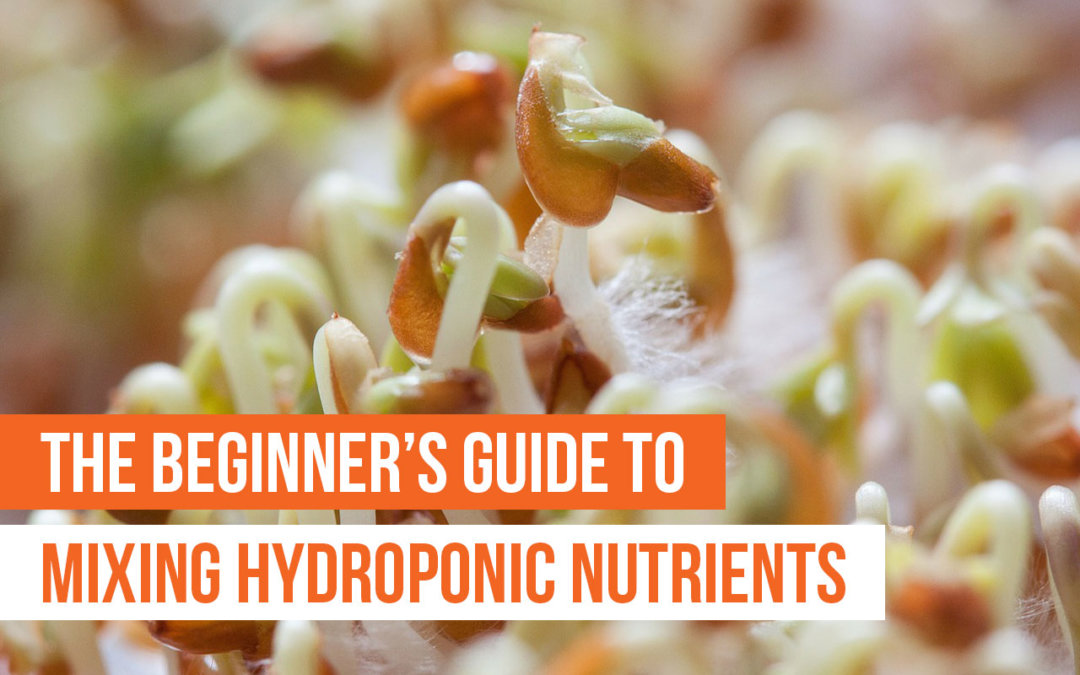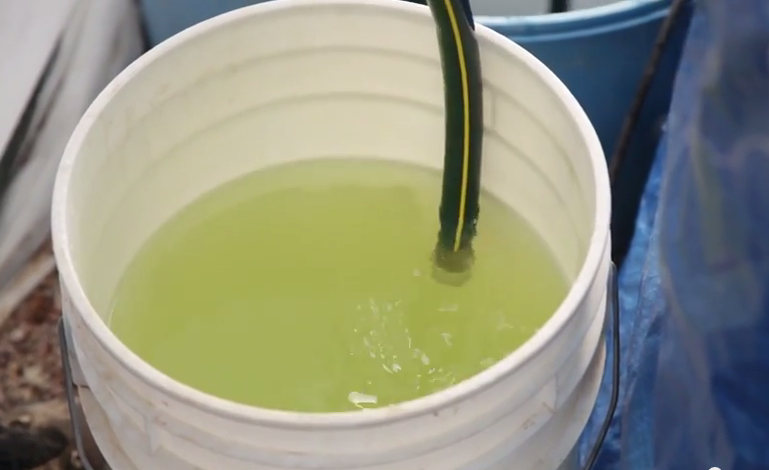So you have a hydroponics system…
But how do you fertilize it?
It seems like it should be easy.
Then you walk into your greenhouse, fertilizer bag in hand, and you realize that you don’t know…
- Where do I add it?
- How much to add?
- Is timing important?
- Do I have to wear gloves?
- What if my kid accidentally drinks some?
(Ok, maybe not that last one. But still…)
Suddenly you’re not so sure.
Don’t worry. Just sit back for a minute and read about what, how, and when to mix into your system.
Mixing hydroponic nutrients can be a breeze!
Choosing your fertilizer
If you haven’t’ already chosen a fertilizer, check out this post and video on choosing. Basically, there are two deciding factors: wet vs. dry, and what crops you’re going to be fertilizing. Don’t forget that different crops have different nutrient demands!
If you’re a commercial grower, there’s a 99% chance that a dry fertilizer will be best for you.
Commercial nutrient mixes also come in dozens of different ratios. I’m talking about nitrogen, phosphorous, and potassium—or NPK—which different plants require in different amounts.
If you’re growing greens, you’ll want to use something different than if you’re growing, say, tomatoes. This will maximize plant health and help you get the best possible production out of your system.
Which nutrients should I add?
Different mixes give you different nutrients.

For hydroponics, you’ll want to have these three nutrient mixes to regularly fertilize your system:
- N-P-K mix
- Calcium nitrate
- Epsom salt (magnesium sulfate)
Your crops will be claiming oxygen, hydrogen, and carbon from the water and air around them. For the most part, you don’t need to worry about those three.
The rest of the primary nutrients are nitrogen, phosphorous, and potassium. Those will be provided in the NPK fertilizer you use.

The secondary nutrients are calcium, magnesium, and sulfur.
If you can’t tell by the name magnesium sulfate, magnesium and sulfur are supplemented in this compound—Epsom salt.
From here you only have the micro-nutrients to deal with and unless you want to buy an expensive auto-dosing system, we suggest treating micro-nutrient deficiencies as they pop up.
You can tell which nutrient deficiencies you might have by examining the symptoms.
Quick tip: when you’re buying Epsom salt, be sure to check the ingredients list. If it has scent, dye, or perfume added, don’t buy it.
Mixing your nutrients
When it comes to mixing nutrients, your familiarity with your system will play to your advantage.
Most practitioners shoot for the sump or mixing tank because it has a crucial factor: turbulence. You want to give your nutrients both space and the turbulence to mix thoroughly. Choose the place in your system that will accomplish this best.
You can either mix each nutrient mix separately then combine the three or add them to your tank separately (but don’t combine the calcium nitrate with anything else when you’re mixing—it’s not compatible with the other parts of the solution).
How much?
Check the label on the nutrient mix you are using and follow the instructions provided there. The amount of Epsom salt you add will also be formulated on the label of your nutrient mix.
How often?
Check your nutrient levels daily. You will likely need to top off your system every few days, and add nutrients to compensate for both plant use and the dilution of the top off.
Do you have the right equipment?
There are two biggies here that everyone is going to need:
- an accurate scale that weighs to the ounce or gram, and
- a container to use on the scale.
Additional buckets, stirring rods, and gloves are optional, but sure wouldn’t hurt to have around.
You’re now ready to start mixing!
So, how do you feel about dosing your system?
As always, we hope this post was helpful, but if you’re still unclear on anything, don’t hesitate to leave a comment.




hello there, your demonstration was pretty cool easy and go!
my question is always i see some demonstration where they start to explain about checking ph of the water you add your solution. and again they check ph once the mix done. how about that, how do you normaly check the ph?
Hi!
Check the pH with a testing kit or a probe. See how it’s done: https://youtu.be/XygVBa1MJq8!
It is very useful for starter like me.many many thanks.
Hello!
I have N-P-K mix, Calcium nitrate and
Epsom salt (magnesium sulfate).
Could you tell me how much
Calcium nitrate for 10L tank
and Epsom Salt for a 10L tank?
For the vegetation gram per liter?
For flow grams per liter?
I’m in Bulgaria.
Thank you very much!
———————-
Ivan—
This will ultimately depend on the manufacturer recommendation on the label. For the chem-gro formulas, we typically use the ratio 1 part NPK to 1 part Calcium Nitrate to 0.6 parts Magnesium. Here is one of their recipe charts for reference https://hydro-gardens.com/wp-content/uploads/2017/12/Burchetts-recipe-2017.pdf
Shall we mix magnesium sulfate with micronutrients
Does the npk vary for different plants ???
Hi ivan,
I have a nft hydroponic farm here in corfu, greece
What help do you need
Ivor
I built 2- 6 barrel containers for a ebb and flow system. I’m using rain water One unit is to be peppers and the other tomatoes. Can you tell me which mix I should use?
do npk and calcium nitrate together mixed with soil for the apple tree to use or we need to mix them saperately with soil for better uptake kindly reply
Hello,
Calcium nitrate should be mixed separately from the NPK. Once each has been mixed and diluted, the two can be combined.
Where is the seven micro nutrients ??is it added in Npk as chelated form??
Hi!
Micronutrients are typically included with a base NPK formula. Check the label of the one you use for the form and amounts of each.
Can I add micronutrient in chelated form in Npk ??
Can i use npk 19 19 19 instead of 4 18 38
I want to make my own masterblend can I made by adding Npk with micronutrient??? In India it is to expensive that is why I’m asking …
hii Sumit,
can you suggest me the best nutrients that can be added to hydroponics?
and where can i buy them with its names? “In India”
Thank you.
I have a 1000 gallon tank. And masterblend formula. How much do i use in the nutrients, calcium nitrate and mag. sulphate.
Sharon—
Here’s a good calculator: https://www.tool-rank.com/tool-blog/editorial/masterblend-hydroponic-fertilizer-calculator-for-any-container-size-201610071988/
Hi sirs
What nutrient and mesurement needed for Hydropinic green house
Mainly lollo rosso and oak lettuce
I have 4000 liters tank
Total plant around 12000
Thank you
I have a lot of sediment from the nutrients on the bottom of the container. Am I adding too much? Should I add a water filter?
Thank you
Hi Kim,
Make sure to mix in hot water, and mix sulfates/phosphates separately from calcium nitrate. If the problem still persists, you can mix with RO filtered water, or just mix the solution to be slightly more dilute (this is assuming you are mixing stock solutions for an auto dosing system!).
Katie
So could I mix magnesium sulfate with Part A NPK for stock dosing concentrate? I only have 2 part doser… part B is the calcium nitrate
Please can I mix Epsom salt and calmag (calcium magnesium) together. Thanks
Hi Felix – Yep, that shouldn’t be a problem. You’d be mixing Magnesium sulfate, Calcium ammonium nitrate, and Magnesium nitrate together. They wouldn’t cause growing problems, but you will have to work with solubility a bit more.
Are they any alternatives for Calcium instead of Calcium Nitrate to mix with Chem-gro’s formulas? How can I bring down the ratio of Nitrogen without losing the Calcium?
Hi Keith, hydrated lime — Ca(OH)2 — can be used to supplement calcium. It’s basic, so it shouldn’t be used in a high-pH system. You can also try calcium chloride as a foliar application (research application before doing it). A third option is calcium chelate.
Hi Amy,
Thank you for the reply. Calcium chelate is an interesting option and I think that will work. Thank you.
hello, am in Tanzania, Africa.
I have started my hydroponics farm (setting is ready… NFT)… Problems arise on the hydroponic nutrients.Here in Tanzania we don’t have any master blend for nutrients,
I tried to some research and find some with (NPK
15:9:20,+3.8s+1.8MgO+Te.YARA mila) Now wht ratio should measures to meet the formula for lettuce.
thanks in advance.
Francis,
Try using the hydrobuddy app, it has many popular formulas that are already calculated. You will just need to add info for the specific raw input you are able to obtain, and it will calculate how much to add. You can also add in nutrient levels from the label of any commercially available nutrient (if it isn’t already in the calculator), add info for your raw inputs, and it will calculate weights to replicate the formula.
Is it necessary to have poly or shade net house
Tropical climate where temperatures ranges from 12 to 45 degree
Hi Anup—you’ll definitely want to solve for controlling the climate inside your growing space, whether that’s shade cloth or a cooling wall, or something else!
Can calicum carbonate made from egg shells and vinegar be used instead of calcium nitrate
Have you found an answer? Calcium Nitrate seems hard to find for many people.
Good day to all. My name is red I m from the Philippines, if you can help me make a recipe in hydroponic nutrient solution. im using yield master 20 20 20. I don’t know how to mix them, maybe you could give me the right ratio in mixing.
Hello,
Thanks for your information. I have a spinach seedling that I just transplanted from peat moss pod to hydroponic solution in a 5 gallon bucket. It’s the second day now and still wilting. Should I test for any other nutrient deficiency other than NPK? If so, how do I test for it?
Hi there, I am new and attempting my first garden in this manner. The issue I am having is where I live, calcium nitrate is not available and even shipping it in, it will be stopped by customs. Is there another way to mix a solution where something else can be substituted for this? I read somewhere that eggshells would work but it was not from someone who gardens this way. Can you help point me in the right direction?
Look into the Cement/ concrete industry.
They use calcium Nitrate as a hardening accelerator.
Every country should have access to this because it is needed in construction.
Can i use CALCIUM AMMONIUM NITRATE instead of Calcium nitrate?
Hi, can I use this approach to calculate fertilizer for soil drenching used in containers plants?
Hi,
Two questions please:
1. Can I use any regular NPK mix? Does the NKP fertilizer need to be water-soluble?
2. I can obtain Epsom salt, but I’m unable to get Calcium Nitrate. However, I can get another fertilizer that contains calcium and has this composition: 15-0-0+24CaO+2MgO+0.3B. Can I add it to the abovementioned NPK mix (20-20-20 + TE)?
Many thanks
Can I mix urea or NPK with Maxicrop for hydroponic system
Hi, Can I mix maxicrop and K44 for hydroponic system. How may teaspoons should be added for 100 gallons.
When I adjust the pH to somewhere 6… some nutrients are starting to precipitates
Hi,
Please share detailed steps for preparation of a N-P-K solution (10:5:5),using differents N,P & K sources for Lettuce.
Thnaks,
Amy, thank you for information!
Okay,
So first of all I have watched a lot of your video’s and love the knowledge that you have about growing. I see that you have so much more to share and are held back to try to keep it simple for us to understand. Thank you for that! I wish there was a better way to be able to ask questions.
1. This video shows the 3 part dry mix that you use for the commercial application that you have on your site. I did try to find some of these and have not yet to get able to find the ones that you use you use. You have show me that you care about how thing are mined and collected and would like to support those companies that have the same heart (https://www.youtube.com/watch?v=h-0DMJUfRHM.On) another video that I watch you mentioned the use of an auto doser that could assist in helping keep thing regulated as it pertains to PH and EC (https://www.youtube.com/watch?v=tI2K45je-Rw). In that video you had talk about the mixture precipitating out. I took that as when we mix it up the nutrients starts to realise. Does that mean that you could not pre mix it in a 55 gallon barrel and just scoop it out when needed. Also, is there a expiration time that nutrients can stay in a system? If i do not have that many plants in the system will it stay in there until they are used? I may have missed that video. Thanks in advance and thanks for your dedication!